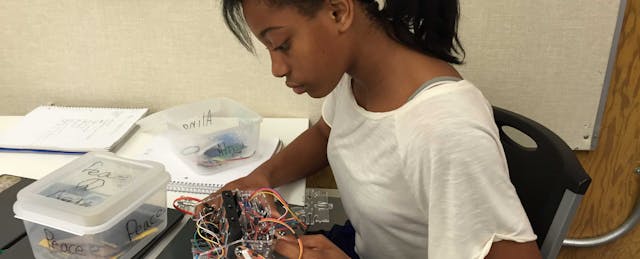A few months ago I left Nashville to implement the hands-on robotics projects my team and I created at Discover Create Advance (DCA). I worked with a group of 7th graders at East Bay Innovation Academy, a charter school in Oakland, California. In my first time using DCA projects to teach principles of physical science as a solo teacher in a traditional classroom setting, I learned that beyond being prepared and organized, running robotics projects requires selecting where to innovate, challenging the students to go deeper, and inviting students to lead.
Innovate on the margins
Student-led innovation is a cornerstone of effective project based learning, but it can be difficult to manage. Using an existing project that has clear goals can provide an excellent foundation on which to innovate. When a student has completed something that works, they have far more confidence to try and fail and try again on an open-ended problem. Starting with a kit or basic project also provides known ways to ensure that key content is included in the student experience. Once the kit has been completed, students can use what they learned to recombine the parts in new and novel ways or add additional parts to the existing kit to demonstrate student-led innovation.
In the classroom in Oakland, the students built DCA’s Scribot (a programmable drawing robot) and then innovated by adding sensors, changing the programming, and designing and building various pieces to make a vehicle that can navigate a model city and perform a municipal function, like raising a fire truck ladder or delivering mail. By adding on to the existing platform students learned to make the project their own-- solving problems of interest to them.
Avoid the path of least resistance
With sophisticated projects come many questions, and there’s no way for one teacher to answer them all. Before students begin the project, they should create a detailed plan for the unknown. What will they do when they don’t know what to do? Where will they get answers? Managing this is key to surviving project-based learning in a middle school classroom.
I asked students to create at least three detailed examples of ways they could solve the problem they were facing before I would give them an answer. Often the very act of writing down the problem will give them a clue to the answer they are seeking. Giving the students more responsibility for problem solving enriches the learning experience and makes the classroom much easier to manage.
Distribute the leadership
Giving students who demonstrate course competency and maturity the chance to be a leader and help other students can make a big difference in what students learn and how engaged they are in the project. A few weeks into the project it should be clear which students have competency to help their peers. I made our student leadership roles optional, but I also made sure they saw it as a privilege. Student leaders should understand that their role is to guide other students to the answer, but not simply provide the answer. Our students helped their peers with everything from how to set up their digital portfolio to how to code and wire their robot.
Project-based learning can be overwhelming, especially with robotics, but the complexity that makes it difficult to implement can also be great for engaging energetic middle school students in deeper learning. Finding ways to focus the places to innovate improves the outcomes of projects, and giving students leadership experiences and ownership of the work boosts engagement, creates real world problem solving, and reduces the classroom management challenges for the teacher.


